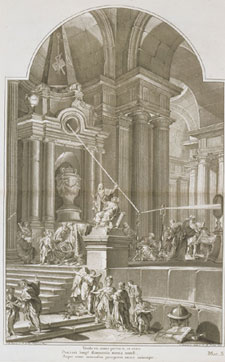Apotheosis
 Plate from Eugene MacSwiny, Tombeaux
Plate from Eugene MacSwiny, Tombeaux
des princes, de grands capitaines
et autres
hommes illustres (London, 1741) – Miriam and
Ira D. Wallach Division of Art, Prints
and Photographs, NYPL
The
deification of Isaac Newton began as early as 1687, when Edmond Halley contributed
a poem to the first edition of the Principia (which he edited), the
final line of which decrees: “no closer to the gods can any mortal rise.” For
the next 150 years, admiration of Newton bordered on idolization; he was immortalized
in verse, carved in stone, his bust prominent in the “temples of worthies” that
proliferated in aristocratic gardens of the eighteenth century. It was a common
practice to hang the portrait of the great Englishman in the study of a scientist
or a man of letters, thereby paying homage – and perhaps hoping for inspiration.
Another way to indicate an intellectual link was to include a bust of Newton
in a commissioned portrait, or at the very least to inscribe his name on the
spine of a book depicted in the background.
Not
a few artists sanctified Newton’s genius or his contribution to science
in their paintings, while shrewd entrepreneurs appropriated his name or portrait
to adorn their firm’s logo. On an institutional level, academies of architecture
announced competitions for designs of cenotaphs to commemorate the “divine” Newton.
With time, the historical Newton receded into the background, overshadowed
by the very legacy he helped create. Newton thus metamorphosed into science
personified.

